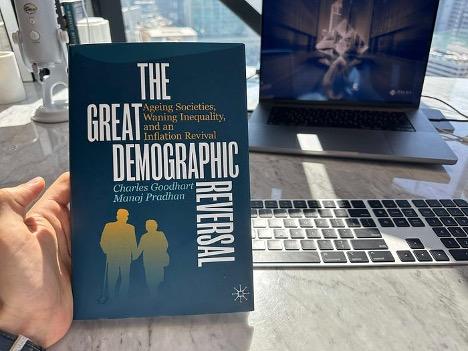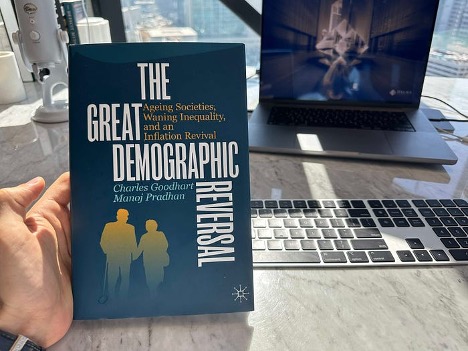Zachary Cefaratti Reviews The Great Demographic Reversal

06 March 2023
By: Zachary Cefaratti
In The Great Demographic Reversal, famed economist Charles Goodhart challenges the commonly held belief that aging societies lead to disinflationary economies. Instead, he argues that aging societies actually put upwards pressure on inflation and nominal interest rates.
Most economists and financial pundits look at Japan as the canary in the coal mine when it comes to the impact of demographic shifts on economies. They point to the country’s stubbornly low inflation over the past few decades as clear evidence of the disinflationary pressure that aging societies will place on economies as populations age and save more while consuming less. Also, the increase in life expectancy has redefined retirement and created fluidity for the 65+ demographic as they continued to work and in some cases re-entered the workforce after retirement.
This logic has always troubled me.
How can this demographic force be disinflationary, ceteris paribus, when in those economies a greater proportion of people are increasingly dependent on a smaller productive workforce? And how can a large portion of the population drawing down on its savings be putting downward pressure on rates?
Goodhart addresses these questions by opposing the often dogmatic arguments of many economists. He notes that Japan did not exist in autarky, and that other forces, beyond just shifting demographics, played a significant role in Japan’s persistently low rates. Goodhart argues with confidence that this demographic shift is actually inflationary and puts upward pressure on nominal rates, challenging widely held views to the contrary.
He believes these inflationary forces will be dominant in most advanced economies, and that the change in China’s role in the global economy coupled with its own demographic shift will reverse a decades-long deflationary force it had on the world’s advanced economies. He warns that this transition will happen in many interconnected markets at once, and that there will be nowhere to turn to avoid this inflationary force for decades to come. To offset these forces, he suggests, would require extremely significant and unlikely advances in productivity, perhaps from technologies such as AI and robotics.
While increased lifespans and good health of the elderly have been held as examples of why demographic shifts have been disinflationary, Goodhart believes that this is also a trend that will work in reverse. He argues that while advancements in treating cancer and heart conditions have prolonged lives, there have been few advancements in preventing dementia which invariably drives the elderly to become highly dependent. As a result, Goodhart predicts an increased number of elderly requiring full-time care, which will contribute to inflationary pressures.
Throughout the book, Goodhart and Pradhan reframe many economic trends in the light of previously favorable demographics in advanced economies and the emergence of China in the global market. They argued that advanced economies previously benefited from entering a temporary ‘demographic sweet spot’, which also contributed to weak nominal wages from decreasing bargaining power of labor, increased inequality within many countries as well as derivative social and political upheaval.
Goodhart and Pradhan also commented on the likely impact of COVID-19. Having published the book in August 2020, well before any concerns about inflation, they anticipated that the response to the pandemic would accelerate the inflection point, particularly given the highly expansionary monetary and fiscal policies that emerged.
They foresaw that the pandemic response would lead to elevated nominal rates, but likely a period of negative real rates as accumulated leverage would lead to financial fragility. Goodhart believed central banks would be left with difficult choices to make, and his view was that central banks would choose to limit tightening and allow inflation to remain elevated in the face of the alternative risks of rapid tightening.
While many of their views are troubling and inconvenient, they do point to some silver linings such as increased incentives for investment and bargaining power for labor, which will help address some of the concerns that have emerged in recent decades around rising inequality within economies. He strongly refutes the central thesis of Thomas Piketty, who suggested that intervention was necessary to address otherwise inelectuable trends. Instead, Goodhart believes that as these forces reverse, there will be a great equilibration between capital and labor.
I found Goodhart’s arguments to be very convincing and believe that the study of demographics and the role it plays on economies is under-appreciated by many investors — most likely due to the fact that such trends span accross decades and are difficult to observe on short horizons. Having also experienced first hand the impact of dementia on my late father, who was otherwise kept healthy by advancements in medicine, I am also concerned about how we will cope with such a large portion of society experiencing this tragic outcome.
I look forward to discussing this with Charles Goodhart at the upcoming AIM Summit conference (www.aimsummit.com), for which Dalma Capital is the lead sponsor.

The Great Demographic Reversal by Charles Goodhart and Manoj Pradhan reviewed by Zachary Cefaratti.
(This article is published by Zachary Cefaratti. The views expressed are his own and do not constitute investment advice.)
To know more about Zachary and his insights, please click here.
To access the Article, please click here.
